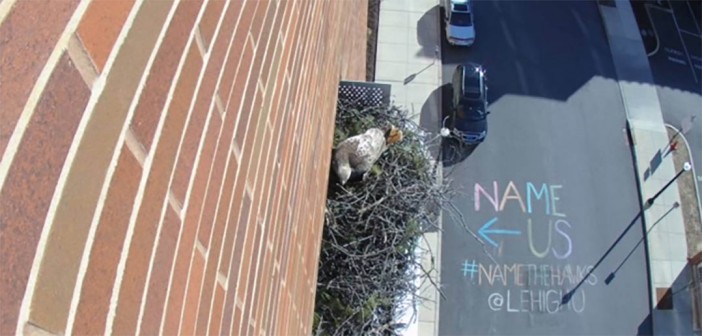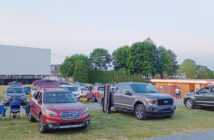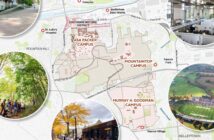The Lehigh community is using a webcam to spy on a local feathered couple.
Several years ago, two red-tailed hawks built a nest on the west side of the STEPS building, along Vine Street. Their activity drew the attention of students, staff and faculty, and inspired George Yasko, Lehigh’s field projects laboratory manager, to install a webcam over their nest that would project a livestream of the hawks’ activities to the Lehigh community.
“People would go up to the lab and watch them,” Yasko said, “and somebody said, ‘Wouldn’t it be cool if we had a camera?’”
Through the joint effort of Facilities Services, STEPS, Library & Technology Services and the Office of Sustainability, the camera was purchased and installed late last fall.
“Right now, the link just works on campus,” Yasko said. “But there’s a lot of people off campus who we would like to get this to, so I’m now trying to work with Library & Technology Services to see if we could open up this feed for the community to look at.”
The @LehighU Twitter account tweets the link to the livestream whenever there is activity in the nest. Students, staff and faculty are becoming increasingly curious about the lives of these two birds. Lehigh has even started a hashtag, #NameTheHawks, to encourage people to suggest names for the male and female hawks.
According to Yasko, the hawks are usually away from their nest during the day and return to their ledge in the evening.
Red-tailed hawks are monogamous and mate for life. Pairs may also defend the same nesting territory for years, and they typically lay their eggs in March or April.
According to a guide to common birds on Lehigh’s campus, red-tailed hawks, which have a characteristic dark band of feathers across their bellies, are the most common hawks on campus and in the valley. They often eat squirrels, particularly in the winter when other sources of food are not easily available.
Yasko suggested the hawks may have chosen to nest on STEPS because it is a good observation place for hunting.
“It could be that it’s a really protected place that fits what they look for in a nest even though it’s not a ‘normal’ place that you might expect,” biological sciences professor Amber Rice said.
Rice researches evolution and speciation by looking at species that hybridize. She and her students keep track of chickadees by setting up nesting tubes in the forest, tagging the birds and observing their behavior.
She feels observing animals, be it in person or through a webcam, is a valuable learning experience.
“The more you can get the public interested and excited in wildlife and science, the better,” Rice said. “They may be more likely to think about those topics when they’re doing things, whether it’s cutting down trees on their property or voting for particular candidates — they’ll have a little bit more appreciation for how nature works and how important it is.”
Rice said studying wildlife allows people to understand how nature works, and how the human footprint — such as in agriculture, pollution and development — affects our world. She believes understanding how nature is supposed to work, before these human impacts take their course, is essential to comprehending consequences.
Biological sciences professor David Cundall, whose interest is herpetology, said that people tend to focus on researching animals that are charismatic, such as birds, rather than specializing in certain other organisms, such as soil nematodes. The problem with trying to increase this kind of research is that there is no money being invested in it, Cundall said.
“There are a lot of organism biologists that are concerned that we aren’t going to know what’s going on, because there no specialists anymore, since federal funding for research for many of those groups of organisms has disappeared,” Cundall said. “So we’re not getting any students, no one’s being trained, and the existing specialists are all getting old and retiring.”
Studying plants, which is what Earth and Environmental Sciences professor Robert Booth does, is also important. Booth’s focus is paleoecology, and he researches how vegetation — particularly forest vegetation — has changed over time and the role that people and the climate have played in driving some of those changes.
Booth’s ecology class has camera traps set up on South Mountain. The cameras have infrared sensors on them, and take pictures anytime an animal walks by.
Although his classes have been monitoring the abundance of deer in particular, they have also captured photos and videos of hawks, wild turkeys, raccoon and foxes, among other animals.
“Most of the animals that we find here are ones that can tolerate living at that interface with people and can deal with fairly small wood lots and forest fragments,” Booth said.
Professors like Rice and Booth use the forest as a natural laboratory for their classes and research.
The hawk cam on STEPS adds increased accessibility to the observation of local wildlife.
“I think having a hawk cam like this and having other kinds of cameras around, it’s a way that’s harmless to the organisms that are being observed,” Rice said. “It gives people a nice connection to nature that most of us don’t have anymore because we live in really populated places and just don’t go outside in wild areas that much.”
Giving the hawks an unexpected space to live and raise their offspring is also a benefit.
“We’re always losing habitat because of new construction,” Yasko said, “and it’s nice to provide some space for some birds, hawks, to be able to nest here.”






Comment policy
Comments posted to The Brown and White website are reviewed by a moderator before being approved. Incendiary speech or harassing language, including comments targeted at individuals, may be deemed unacceptable and not published. Spam and other soliciting will also be declined.
The Brown and White also reserves the right to not publish entirely anonymous comments.